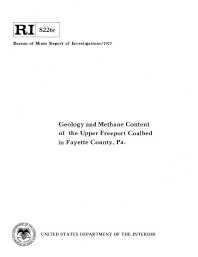Mining Publication: Geology and Methane Content of the Upper Freeport Coalbed in Fayette County, Pa.
Original creation date: January 1977
As part of the Bureau of Mines methane control program, the Upper Freeport coalbed was studied in Fayette County, Pennsylvania, where this coalbed lies about 650 feet below the Pittsburgh coalbed and contains the largest remaining reserves of any coalbed in the county. Coal and overburden isopachs, structure and joint pattern maps, and a fence diagram were prepared using data from gas and oil exploration logs and coal outcrops. These maps will aid in determining the need and/or feasibility of degasifying the Upper Freeport coalbed in the study area. Much of the coalbed in this area is under 600 to 1,400 feet of overburden. By correlation with data from the Pittsburgh coalbed, the gas content at depths of this order is estimated to be between 140 and 300 cu ft/ton of coal, for a total of 190 to 400 billion cubic feet of methane in this coalbed in Fayette County.
Authors: PF Steidl
Report of Investigations - January 1977
NIOSHTIC2 Number: 10007798
Pittsburgh, PA: U.S. Department of the Interior, Bureau of Mines, RI 8226R, 1977 Jan; :1-17
See Also
- Experimental Studies on the Origin and Accumulation of Coalbed Gas
- Forecasting Methane Hazards in Metal and Nonmetal Mines
- Geologic Factors Causing Roof Instability and Methane Emission Problems: The Lower Kittanning Coalbed, Cambria County, Pa
- Geologic Factors Influencing the Gas Content of Coalbeds in Southwestern Pennsylvania
- Geological Factors Affecting Methane in the Beckley Coalbed
- Geology and Gas Content of Coalbeds in Vicinity of Bureau of Mines, Bruceton, Pa.
- Hydraulic Stimulation of a Surface Borehole for Gob Degasification
- Remote Methane Sensors
- Removing Methane (Degasification) from the Pittsburgh Coalbed in Northern West Virginia
- Reservoir Rock Properties of Coal Measure Strata of the Lower Monongahela Group, Greene County (Southwestern Pennsylvania), from Methane Control and Production Perspectives
- Content source: National Institute for Occupational Safety and Health, Mining Program


 ShareCompartir
ShareCompartir
